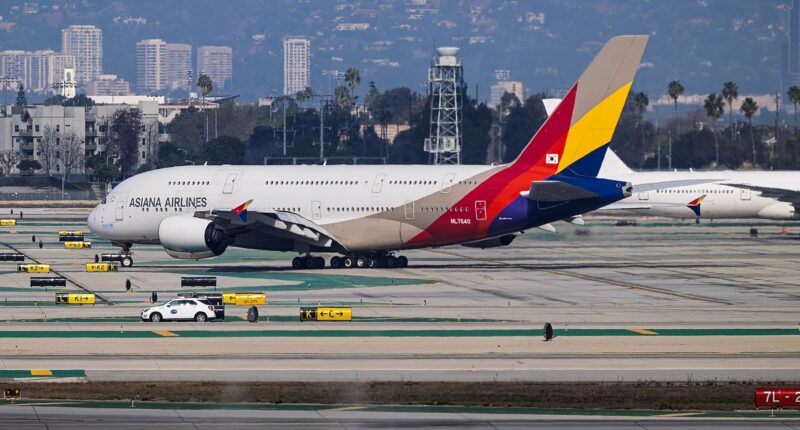Share this @internewscast.com
Passengers on a flight from South Korea to New York were put into quarantine over fears of a ‘highly infectious’ contagion on board.
An Asiana Airlines flight from Seoul to New York was diverted to Winnipeg, Canada, at 6:30 am local time on Wednesday, as indicated by flight radar.
Upon landing, a passenger was removed and transported to St Boniface Hospital, where they were temporarily placed in a social containment unit, according to a government spokesperson in Canadian media.
The passenger has since been taken out of the unit.
The remaining passengers stayed on the tarmac at Winnipeg Richardson International Airport for nearly four hours before the plane continued its journey to New York.
It landed at John F Kennedy International airport at 2:35pm eastern time.
The spokesperson said the quarantine was a precaution for a ‘very contagious’ disease, though the contagion has not been revealed.
All necessary precautions were taken and there is no threat to anyone on board the plane, according to the spokesperson.

One of the passengers on the Asiana Airlines flight was quarantined in Canada for an unspecified infectious disease (stock image).
Officials did not reveal details about the passenger’s condition or the contagion they were investigating.
The CDC outlines that the US can enforce isolation and quarantine for diseases such as cholera, diphtheria, active tuberculosis (TB), plague, smallpox, yellow fever, viral hemorrhagic fevers like Ebola and Marburg, severe acute respiratory syndromes (SARS), influenza A, and measles at entry ports.
In recent months, passengers on US-bound flights have frequently brought measles, the most contagious respiratory virus globally.
It spreads via airborne droplets released in coughs and sneezes, which can hang in the air for up to two hours after a patient passes.
Symptoms usually begin seven to 21 days after exposure, so many patients don’t know they have been infected until they have already exposed dozens, if not hundreds, of others.
And the airborne droplets can spread more easily in the enclosed space and dry air of an airplane cabin.
In the current US measles outbreak, 21 of the 1,454 total cases reported in 2025 are from international visitors traveling to the US.
Ebola is another concern for international travel, especially amid an outbreak in the Democratic Republic of the Congo (DRC) that has infected 68 people.
In February of this year, for example, New York City suspected two cases of Ebola in patients who had recently traveled to Uganda, where an outbreak was occurring at the time.
It was later confirmed that they did not have Ebola, but it was not revealed what illness they were suffering from.

Health officials did not say what the suspected illness was, though conditions like tuberculosis, measles and hepatitis can trigger a quarantine (stock image)

The CDC reports 21 cases of measles, which causes the signature rash pictured above, this year were brought into the US from international travelers (stock image)
Ebola is spread by contact with the blood or body fluids of an infected person, as well as contact with contaminated objects or infected animals such as bats or primates.
Symptoms include fever, headache, muscle pain and weakness, diarrhea, vomiting, abdominal pain and unexplained bleeding or bruising. It has a mortality rate as high as 90 percent without treatment.
In South Korea, where the flight this week originated from, there are higher incidences of illnesses like tuberculosis and hepatitis, which could also trigger a quarantine.
Tuberculosis, the world’s deadliest disease, is a respiratory disease caused by Mycobacterium tuberculosis. Though rare in the US, it kills 1.25million people worldwide every year.
It causes persistent and unexplained cough, coughing up blood, unexplained weight loss, fever and severe breathing issues.
Though deadly, tuberculosis generally only infects those who have spent a significant amount of time exposed to it.
Viral hepatitis, meanwhile, inflames the liver and can be spread through contaminated food or water, sharing needles or contact with another person’s bodily fluids, depending on the type.
The CDC estimates there are 3,300, 14,400 and 69,000 infections every year of hepatitis A, B and C, respectively.








